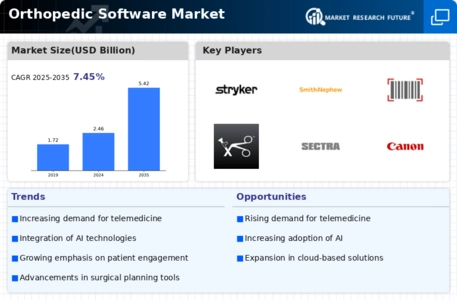The Orthopedic Software Market is currently characterized by a dynamic competitive landscape, driven by technological advancements and an increasing demand for efficient surgical solutions. Key players such as Medtronic (US), Stryker (US), and Zimmer Biomet (US) are at the forefront, each adopting distinct strategies to enhance their market positioning. Medtronic (US) focuses on innovation through the integration of AI and machine learning into its software solutions, aiming to improve surgical outcomes and streamline workflows. Stryker (US), on the other hand, emphasizes strategic partnerships and acquisitions to expand its product offerings and enhance its technological capabilities. Zimmer Biomet (US) is actively pursuing digital transformation initiatives, which include the development of cloud-based platforms to facilitate better data management and patient care. Collectively, these strategies contribute to a competitive environment that is increasingly centered around technological innovation and operational efficiency.
In terms of business tactics, companies are localizing manufacturing and optimizing supply chains to enhance responsiveness to market demands. The Orthopedic Software Market appears moderately fragmented, with several key players exerting influence while also facing competition from emerging firms. This structure allows for a diverse range of solutions, catering to various customer needs and preferences, thereby fostering a competitive atmosphere that encourages continuous improvement and innovation.
In August 2025, Medtronic (US) announced the launch of its new AI-driven surgical planning software, which is designed to assist orthopedic surgeons in preoperative decision-making. This strategic move is significant as it not only enhances the precision of surgical procedures but also positions Medtronic as a leader in the integration of advanced technologies within orthopedic practices. The introduction of such innovative solutions is likely to attract a broader customer base, thereby strengthening Medtronic's market share.
In September 2025, Stryker (US) completed the acquisition of a leading telehealth platform, which is expected to enhance its orthopedic software capabilities. This acquisition is strategically important as it allows Stryker to offer comprehensive remote monitoring and consultation services, thereby addressing the growing demand for telehealth solutions in orthopedic care. By integrating these services into its existing product line, Stryker is likely to improve patient engagement and satisfaction, further solidifying its competitive edge.
In July 2025, Zimmer Biomet (US) launched a new cloud-based data analytics platform aimed at improving patient outcomes through enhanced data insights. This initiative reflects Zimmer Biomet's commitment to digital transformation and positions the company to leverage big data in orthopedic care. The ability to analyze patient data effectively can lead to more personalized treatment plans, which may enhance the overall quality of care and patient satisfaction.
As of October 2025, the Orthopedic Software Market is witnessing trends such as increased digitalization, sustainability efforts, and the integration of AI technologies. Strategic alliances among key players are shaping the competitive landscape, fostering innovation and collaboration. Looking ahead, it is anticipated that competitive differentiation will increasingly hinge on technological advancements and supply chain reliability, rather than solely on price. This shift underscores the importance of innovation and the ability to deliver high-quality, efficient solutions in a rapidly evolving market.

















Leave a Comment